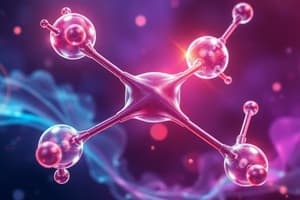Podcast
Questions and Answers
What type of hybridization occurs in a methane molecule (CH4)?
What type of hybridization occurs in a methane molecule (CH4)?
- sp2
- sp3 (correct)
- sp
- s
Which of the following bond angles is associated with sp2 hybridization?
Which of the following bond angles is associated with sp2 hybridization?
- 109.5°
- 180°
- 90°
- 120° (correct)
In sp3 hybridization, how many equivalent hybrid orbitals are formed?
In sp3 hybridization, how many equivalent hybrid orbitals are formed?
- 2
- 3
- 5
- 4 (correct)
What must occur for carbon to achieve sp3 hybridization from its ground state?
What must occur for carbon to achieve sp3 hybridization from its ground state?
Which of the following describes the geometry of sp3 hybridized compounds?
Which of the following describes the geometry of sp3 hybridized compounds?
How are the π bonds formed in sp2 hybridized compounds?
How are the π bonds formed in sp2 hybridized compounds?
What is the hybridization type of carbon in ethylene (C2H4)?
What is the hybridization type of carbon in ethylene (C2H4)?
What does the term 'tetrahedral' refer to in sp3 hybridization?
What does the term 'tetrahedral' refer to in sp3 hybridization?
What is the bond angle formed in a molecule with sp hybridization?
What is the bond angle formed in a molecule with sp hybridization?
Which type of bond is formed when there is a difference in electronegativity greater than 2?
Which type of bond is formed when there is a difference in electronegativity greater than 2?
What distinguishes a double bond from a single bond in terms of hybridization?
What distinguishes a double bond from a single bond in terms of hybridization?
Which of the following correctly describes the geometrical arrangement around a central atom with sp3 hybridization?
Which of the following correctly describes the geometrical arrangement around a central atom with sp3 hybridization?
What is the primary difference between polar and non-polar covalent bonds as defined by electronegativity?
What is the primary difference between polar and non-polar covalent bonds as defined by electronegativity?
In the context of hybridization, how many unhybridized orbitals are present in a molecule with sp2 hybridization?
In the context of hybridization, how many unhybridized orbitals are present in a molecule with sp2 hybridization?
What is the electronegativity value range that commonly provides a non-polar covalent bond?
What is the electronegativity value range that commonly provides a non-polar covalent bond?
Which of the following statements about hybridization is correct?
Which of the following statements about hybridization is correct?
Flashcards
What is hybridization?
What is hybridization?
Mixing of atomic orbitals to form new hybrid orbitals suitable for bonding.
What is sp3 hybridization?
What is sp3 hybridization?
Hybridization involving one s orbital and three p orbitals, resulting in tetrahedral geometry.
What is sp2 hybridization?
What is sp2 hybridization?
Hybridization involving one s orbital and two p orbitals, resulting in trigonal planar geometry.
What is sp hybridization?
What is sp hybridization?
Signup and view all the flashcards
What is single (σ) bond?
What is single (σ) bond?
Signup and view all the flashcards
What is a pi (π) bond?
What is a pi (π) bond?
Signup and view all the flashcards
What is electronegativity (EN)?
What is electronegativity (EN)?
Signup and view all the flashcards
What is an ionic bond?
What is an ionic bond?
Signup and view all the flashcards
What is a covalent bond?
What is a covalent bond?
Signup and view all the flashcards
What is a non-polar covalent bond?
What is a non-polar covalent bond?
Signup and view all the flashcards
What is a polar covalent bond?
What is a polar covalent bond?
Signup and view all the flashcards
Study Notes
Introduction
- Hybridization explains how atomic orbitals mix to form new hybrid orbitals, which are more suitable for bonding.
Types of Hybridization
- sp3 Hybridization:
- Involves one s orbital and three p orbitals.
- Forms four equivalent sp3 hybrid orbitals with tetrahedral geometry.
- Bond angles are 109.5°.
- Example: Methane (CH4).
- sp2 Hybridization:
- Involves one s orbital and two p orbitals.
- Forms three sp2 hybrid orbitals with trigonal planar geometry.
- Bond angles are 120°.
- Example: Ethylene (C2H4).
- sp Hybridization:
- Involves one s orbital and one p orbital.
- Forms two sp hybrid orbitals with linear geometry.
- Bond angles are 180°.
- Example: Acetylene (C2H2).
Comparison of Hybridization Types
| Category | sp3 | sp2 | sp |
|---|---|---|---|
| Number of Hybridized Orbitals | 4 | 3 | 2 |
| Number of Unhybridized Orbitals | 0 | 1 | 2 |
| Geometry around Central Atom | Tetrahedral | Trigonal Planar | Linear |
| Bond Angle around Central Atom (°) | 109.5 | 120 | 180 |
Carbon-Carbon Bonds
- Single C-C bond: Formed by one sigma bond (σ).
- Double C=C bond: Formed by one sigma bond (σ) and one pi bond (π).
- Triple C≡C bond: Formed by one sigma bond (σ) and two pi bonds (π).
Electronegativity (EN)
- It is the ability of an atom to attract electrons.
- The higher the EN, the stronger the attraction for electrons..
Types of Chemical Bonds
- Ionic bond:
- Formed when the difference in EN is greater than 2.
- Involves the transfer of electrons from one atom to another.
- Creates cations (positively charged) and anions (negatively charged).
- Example: NaCl (sodium chloride).
- Covalent bond:
- Formed by the sharing of electrons between two atoms.
- Non-polar covalent bond:
- Difference in EN is 0.5 or less.
- Example: C-C, Br-Br, C-H.
- Polar covalent bond:
- Difference in EN is between 0.5 and 2.
- Example: H-O, C-Cl.
Studying That Suits You
Use AI to generate personalized quizzes and flashcards to suit your learning preferences.




